Read Time: 5 Minutes Subscribe & Share
A Winter Harvest
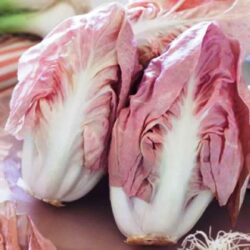 One of the joys of the dreary JanFebs (thank you Liz DiGregorio for this perfect descriptor) in Italy for the newly transplanted me is the plentitude of red, pink, green, frilly and closed-leaf family of radicchio. Technically, it’s a member of the chicory family, which like cilantro, you might either love or hate. Its season is now, just when you think you will be reduced to eating rutabagas and other dense-root vegetables. It makes a great salad with an anchovy dressing – or you can mix it in with the somewhat lackluster lettuces grown hydroponically or in cold frames and winter greenhouses.
One of the joys of the dreary JanFebs (thank you Liz DiGregorio for this perfect descriptor) in Italy for the newly transplanted me is the plentitude of red, pink, green, frilly and closed-leaf family of radicchio. Technically, it’s a member of the chicory family, which like cilantro, you might either love or hate. Its season is now, just when you think you will be reduced to eating rutabagas and other dense-root vegetables. It makes a great salad with an anchovy dressing – or you can mix it in with the somewhat lackluster lettuces grown hydroponically or in cold frames and winter greenhouses.
A Bitter History
The city of Chioggia is considered by many in the US to be the lodestar of radicchio, and indeed the most common form found in grocery stores is the round and tight-leafed Chioggia radicchio. But in Italy, I just discovered there are several Radicchio Fairs where new types, best-of-classic varieties and twists in the growing technology are displayed. If you go to  Smarties.bio which sells an astonishing array of heirloom seeds, you can enjoy looking at the many varieties that have been bred. The history of breeding this cold-weather vegetable in Italy goes back to the fifteenth century in the Veneto region, and several cities claim sovereignty over certain varieties.
Smarties.bio which sells an astonishing array of heirloom seeds, you can enjoy looking at the many varieties that have been bred. The history of breeding this cold-weather vegetable in Italy goes back to the fifteenth century in the Veneto region, and several cities claim sovereignty over certain varieties.
The propagation and proliferation of different forms of this red to pink winter leafy plant probably owes its development to the brutal ravages suffered by this area during World War I. While The Great War led to the collapse of the Ausrto-Hungarian Empire and Istria and the Tyrol were ceded to Italy, the culminating Battle of Vittorio Veneto cost this area dearly. Thousands of civilians died from starvation and in refugee camps. One of the outcomes was the state encouragement of developing varieties of vegetables that could be harvested in winter.
Plays Well With Others
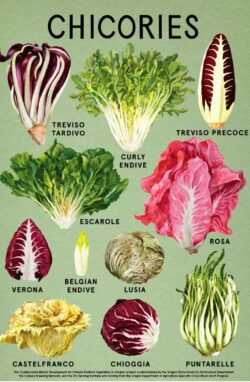 I have always loved the bittersweet taste of these chicory varieties, which can be hard to find in the US. There has been some resistance from another person living with me, but with these new-to-us varieties, I have been able to entice him with some (but of course not all) recipes that I am seduced into trying.
I have always loved the bittersweet taste of these chicory varieties, which can be hard to find in the US. There has been some resistance from another person living with me, but with these new-to-us varieties, I have been able to entice him with some (but of course not all) recipes that I am seduced into trying.
One of the simplest ways to incorporate the familiar Chioggia or the gorgeous Treviso radicchio is to mix it with sautéed cabbage. This is really not a “recipe” as my Italian son-in-law keeps reminding me, but rather a procedure. You combine a small amount of olive oil and butter (1/4 cup and 1/8 cup for my recipe-needy self) and a finely diced small onion (white, red, or yellow will give you slightly different background flavors) . Over medium low heat in a large frypan or rondeau, melt the butter and olive oil together and then add the diced onion. When the onion is translucent and soft but not brown, add 3 cups each thinly sliced cabbage and radicchio to the pan and sauté until they are both soft. Add 1/2 cup white wine, some salt and freshly ground pepper to taste (I sometimes use crushed pink peppercorns). You can add some crushed cumin or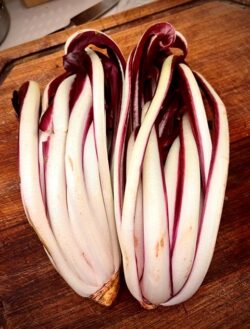 thyme at this point. Allow the wine to evaporate. The mix should have lost its crunch – and some of its spicy bitterness. Turn off the heat when the texture and flavor you like is achieved, cover and allow it to sit at room temperature until you are ready to serve. I have let this preparation sit for as long as an hour while preparing dinner. If it has cooled too much, gently reheat before serving. This off-the-heat covered steaming process will give you a lovely melding of flavors.
thyme at this point. Allow the wine to evaporate. The mix should have lost its crunch – and some of its spicy bitterness. Turn off the heat when the texture and flavor you like is achieved, cover and allow it to sit at room temperature until you are ready to serve. I have let this preparation sit for as long as an hour while preparing dinner. If it has cooled too much, gently reheat before serving. This off-the-heat covered steaming process will give you a lovely melding of flavors.
During the pandemic, I discovered how well radicchio goes with winter varieties of pumpkin and particularly butternut squash. Try this dish if you are looking for a new combination for your winter squash purchases. Radicchio is a great addition to risotto, and I included one in an earlier post about the rice used for risotto. This version with sausage developed by the Italy Insider is a killer winter meal. I will be surprised if you have leftovers.
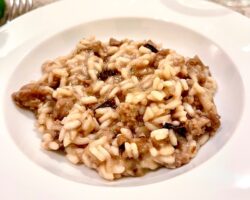

- generous 2 cups (475ml) Carnaroli rice
- 6-8 cups (1 1'2 - 2L) vegetable or meat stock
- olive oil
- butter
- medium white onion, finely diced
- 3 cups (710ml)diced Treviso radicchio
- 10-12oz (285-340gr)all pork sausage (not American Breakfast sausage with sage)
- salt and pepper to taste
- 1/2 cup white wine
- grated Parmigiano cheese.
- Heat the stock of choice over low flame and make sure it stays hot without too much evaporation.
- Combine enough olive oil and butter to just film the bottom of your pan and allow it to melt.
- Add the onion and saute until soft and translucent. .
- If sausage is in casings, remove the casings and crumble into the pan. l brown the pieces slightly.
- Add the rice and allow it to cook in the fat with the onion and sausage.
- Add the wine and let it evaporate before adding the first ladle of stock.
- As you add the stock, count the time - the risotto should be finished in under 20 minutes.
- Add ladle of stock - one at a time- stir it into the rice before adding the next one.
- You can add the grated parmigiano cheese at the end, before serving.
- Ladle into bowls or plates and serve.
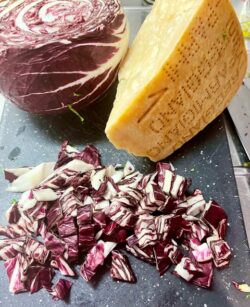 This following recipe makes use of chickpeas, which have meaningful lives beyond their starring role in hummus. I prefer the dried form and, yes, soaking beans and then cooking them takes a lot more time than opening a can, but the taste difference is noticeable. Cooking dried chickpeas (or actually any dried bean) with a bay leaf, tired onion, limp carrot and celery – something we probably all have in our fridge – will reward you with a subtle flavor boost in your beans. Chickpeas take a long time to cook thoroughly, as I found out the hard way. They need to be completely soft in the interior. You can freeze chickpeas after cooking and use them in salads, such as this one, or add them to pasta or rice.
This following recipe makes use of chickpeas, which have meaningful lives beyond their starring role in hummus. I prefer the dried form and, yes, soaking beans and then cooking them takes a lot more time than opening a can, but the taste difference is noticeable. Cooking dried chickpeas (or actually any dried bean) with a bay leaf, tired onion, limp carrot and celery – something we probably all have in our fridge – will reward you with a subtle flavor boost in your beans. Chickpeas take a long time to cook thoroughly, as I found out the hard way. They need to be completely soft in the interior. You can freeze chickpeas after cooking and use them in salads, such as this one, or add them to pasta or rice.
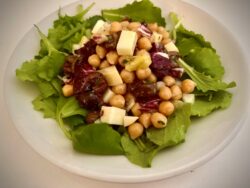

- 2-3 tablespoons finely chopped flat leaf parsley or cilantro
- 2 tablespoons fresh lemon jouice
- 2 tablespoons Parmigiano cheese grated on a Microplane
- 1/2 to 1/3 cup olive oil (you probably won’t use it all)
- fine sea salt to taste
- For the Salad
- 3 cups cooked chickpeas
- 1-2 cups diced Chioggia Radicchio
- 1 cup diced smoked mozzarella or similar smoked cheese
- 1/2 cup split pitted small black olives
- 2 tablespoons finely diced white onion
- In a small bowl, add the lemon juice, parsley or cilantro, and grated cheese - whisk them together thoroughly.
- Using a good quality olive oil, add this to the lemon juice mixture while whisking continually.
- Whisk thoroughly until you have a dressing with a creamy consistency and the lemon juice flavor is not too sharp - sometimes it takes more olive oil to balance out the acidity of the lemon.
- Add salt and some pepper if you want a sharper flavor.
- In a large bowl, combine the chickpeas, the diced smoked cheese, radicchio, olives and onion and combine.
- Fold in the dressing and serve.
 Oregon called the Culinary Breeding Network and they are crazy about fostering radicchio varieties as crops for local farmers. The group was inspired by the Sagre in Italy that are devoted to a particular food, and they have initiated their own Radicchio Sagra. For the KD readers who farm and are curious to try growing this intriguing plant, you can do no better than purchasing Franchi seeds through Seeds Of Italy I was first introduced to Franchi seeds by Liz DiGregorio whose love of gardening is matched by her planning of Italian trips. Franchi seeds are fresher than some I have tried from their competitors. I had really good results even in my pots on my deck!
Oregon called the Culinary Breeding Network and they are crazy about fostering radicchio varieties as crops for local farmers. The group was inspired by the Sagre in Italy that are devoted to a particular food, and they have initiated their own Radicchio Sagra. For the KD readers who farm and are curious to try growing this intriguing plant, you can do no better than purchasing Franchi seeds through Seeds Of Italy I was first introduced to Franchi seeds by Liz DiGregorio whose love of gardening is matched by her planning of Italian trips. Franchi seeds are fresher than some I have tried from their competitors. I had really good results even in my pots on my deck!

Kitchen Detail shares under the radar recipes, explores the art of cooking, the stories behind food, and the tools that bring it all together, while uncovering the social, political, and environmental truths that shape our culinary world.




I have always loved radiccio and now have new recipes to try! My all time favorite along with endive! thank you. Elinor
Elinor,
If you have a recipe or two that already love, I would love to try them. I just love cooking with the varieties here.
NAancy